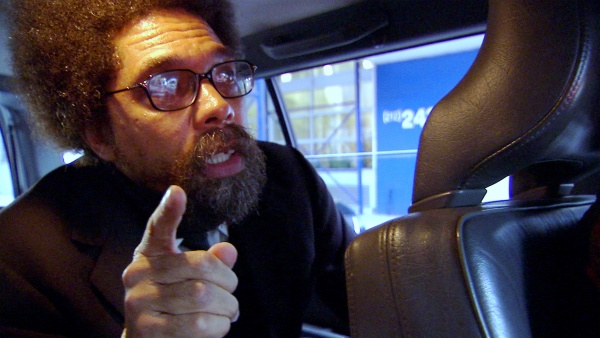
“I feel like I’m a woman with vision — in 3D,” says my fully dimensioned friend Melissa Butts, co-director of 3D Sun and principal force behind the Minneapolis-based Melrae Pictures.
“Where I don’t consider myself a woman with vision is in the sense of being a female director,” she continues. “I happened to co-direct this film [with Barry Kimm]. Will I direct other films? Not necessarily. It’s not my passion. But I have wanted to be a pioneer in this revolutionary field of 3D storytelling.”
Butts’s 3D Sun, comin’ at ya this weekend as part of the Walker’s “Women With Vision: Dimensions,” is a hot property in many ways, as well as the rare movie of any depth whose stated intent is thoroughly fulfilled. In the very first moments of the 22-minute film, over an eyepopping image of the titular fireball, a female narrator promises: “You are going to see a star, an astrophysical object, in three dimensions, with great resolution, for the very first time.” Ah, if only all movies offered such truth in advertising.
Visionary indeed, Butts was far ahead of the curve in recognizing hi-def 3D — the future of commercial movies, many claim — as an emerging market. Four years ago, she delivered a stereoscopic version of another outer-space documentary she made with Kimm, Future Frontiers: Mars, to the Science Museum of Minnesota, which had just installed a 3D digital projection system in one of its theaters. The challenge of inventing the wheel — or reel, virtually speaking — was precisely the appeal for Butts.
“You get intoxicated by the challenge of pushing the big rock up the hill, trying to figure it all out,” she says. “There weren’t a lot of people doing [digital 3D] then. What we were doing was more than cutting edge. It was like bleeding edge.”
3D Sun, too, has been “up-rezzed,” this time to giant-screen IMAX for its current screenings at the Smithsonian’s Air and Space Museum on the National Mall in Washington, DC.
At the Walker this weekend (every half-hour in the Lecture Room, from Friday thru Sunday), the film’s third dimension will emerge through the combination of two carefully synched Panasonic HD projectors, a gigantic server, and a special silver screen.
When asked to measure the film’s gargantuan size, Butts (who’ll speak in the Lecture Room at 4 p.m. on Saturday) says that she and Kimm, working in close collaboration with NASA and various computer animators from Minnesota and beyond, amassed some 150,000 .tif files — i.e., 75,000 for each eye.
Alas, the numbers of 3D filmmakers aren’t so evenly proportioned when it comes to gender.
Butts was one of only three women presenting work at 3DX, a film festival held in Singapore last November. The others — Catherine Owens (co-director of U2 3D) and Charlotte Huggins (co-producer of Journey to the Center of the Earth) — realized the extent of their minority and, as Butts recalls, said to her, “Is this crazy or what? There are only three women here — us!”
Even having two female colleagues is rare in a milieu where, Butts says, “you kind of get used to being one of the few women in the room.” A Parisian woman whom Butts met at a festival in France last summer suggested they form a Women’s Stereoscopic Society by way of banding together.
“3D Sun was screening at this [French] festival,” Butts says, “but there were no women presenting content to the audience, no women talking about their role in digital cinema, 3D or otherwise. We all noticed it.”
Which, Butts agrees, is another way of noting the continued necessity of a women’s film festival.

Not to get all Bill & Ted in this excellent adventure, but what would ol’ Socrates have made of 3D Sun?
Beyond the near-certain probability that the flick would’ve flipped his wig, we can’t know how the ancient philosopher (“The unexamined life is not worth living”) would have reviewed it. But thanks to Astra Taylor’s Examined Life, screening March 13 at “Women With Vision,” we can study Martha Nussbaum’s take on social democracy, Peter Singer’s meditation on the (im)morality of conspicuous consumption, Kwame Anthony Appiah’s ode to human evolutionary cosmopolitanism, and Cornel West’s theories of death and desire. Slavoj Zizek, star of Taylor’s earlier doc Zizek!, appears in the film beside a garbage heap as he recycles his own notions of ecological ideology.
As I wrote in Variety from Toronto last fall, Examined Life serves as a playful riposte to the idea that movies are mainly for turning one’s mind off. The same could be said of the other “WWV” films I’ve seen and loved, including Claire Simon’s reproductive rights tract God’s Offices (a suitably unplayful riposte to Juno, one could say) and Katia’s Sister by Mijke de Jong, who trains a piercing lens on a Russian emigrant girl’s rough acclimation to life in Amsterdam in a manner that recalls Rosetta.
Before you say there’s nothing new under the sun, examine how life in these distinctly Dardennes-esque dramas appears different for having been captured not by brothers, but sisters.
Get Walker Reader in your inbox. Sign up to receive first word about our original videos, commissioned essays, curatorial perspectives, and artist interviews.